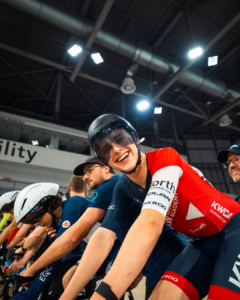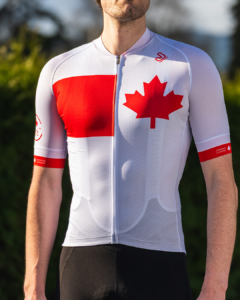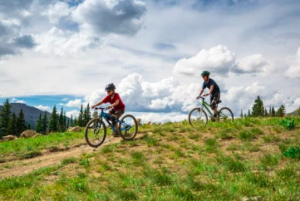STRENGTH TRAINING WITH MINIMAL EQUIPMENT FOR A CYCLIST
By Greg Lewandowski, Strength and Conditioning Coach with the Canadian Sport Institute Ontario
While most cycling disciplines require a big aerobic engine to meet the demands of an endurance sport, adding a layer of strength not only provides the cyclist the ability to produce high-power outputs during short bursts (e.g., the ability to close a gap), but also decreases the likelihood of sustaining an injury. Mitigating the risk for injury will allow cyclists to continue to ride their bikes, which is ultimately key to improving cycling performance.
One of the most common misconceptions within the cycling community is that you need to have access to a fully equipped gym in order to maximize the benefits of strength training. While this may partially be true for an athlete with an extensive strength training background, there are still several key exercises that can be done with little to no equipment. So, whether you are away travelling or are just trying to maintain strength at home, there are plenty of key exercises that can be done, regardless of environment and access to equipment.
The key to improvement is consistency, not complexity. A short circuit of basic exercises done 1-2x per week, regardless of the time of the year, will be more beneficial than an extensive gym program with complicated exercises done periodically throughout the year.
The Importance of Technique
Just like pedaling technique is important, movement quality during strength exercises is imperative. During the pedal stroke, the knee should track roughly in line with your hip and foot in order to effectively transfer force into the pedal. More importantly, this will limit any unnecessary stress that may be placed on the hip and knee joint. Poor pedaling efficiency coupled with the repetitive nature of pedaling may eventually lead to injury. Given that strength training is conducted in a more controlled environment, it provides the opportunity to focus on movement quality, with the hope of carrying over this quality onto the bike.
It is essential that your knee, hip and ankle are all aligned during the recommended lower body exercises.
Lower Body Exercises
During the downward portion of a pedal stroke, the majority of power is generated by hip extensors (glutes), knee extensors (quadriceps) and plantar flexors (calves). This article will describe exercises that target the glutes and quadriceps.
Squat
Relevance: Squats support the lower body by developing strength in the glutes and quadriceps during downstroke. It also helps develop a strong, stable base for pushing into the pedal.
Modifications: This exercise can be made more challenging by holding weighted implements (e.g., dumbbells), adding a band or by simply pausing/holding the exercise when in the bottom position.
Coaching Tip: Feet should be about shoulder width apart, and knees should be aligned with the hips and feet.
Split Squat
Relevance: Cycling involves uses each leg in alternation; therefore, using single leg exercises allows the focus to be placed on each leg individually. This will target any imbalances between the two limbs.
Modifications: The exercise can be made more challenging by holding weighted implements, adding a band or by simply pausing/holding the exercise when in the bottom position.
Coaching Tip: Create two 90-degree angles (approximately) with the front and back legs during the lowering phase.
Upper Body Exercises
Although maybe not as evident in cycling, the upper body still plays an important role in creating stability during climbs and sprints. Difficulties in creating stability through the upper body will negatively affect the force that can be transmitted into the pedal through the lower body.
Push Up
Relevance: Push ups develop the muscles (i.e., pectorals and triceps) necessary to support the upper body in a basic riding position.
Modifications: The exercise can be made more challenging by elevating your feet off the ground. On the other hand, if pushing up from the ground is too difficult, you may push off a bench instead to elevate the upper body.
Coaching Tip: Lead with your chest and not your chin when lowering yourself towards the floor or bench.
Core
Hip Bridge
Relevance: Hip bridges target the glutes, which are important for pelvic stability. Pelvic stability is instrumental in the efficient pedal stroke of the cyclist.
Modifications: Hip bridges can be made more challenging by doing them on one leg at a time. This will increase the stability demands of the exercise.
Coaching Tip: Focus on squeezing the glutes when in the top position rather than extending the hips through the lower back.
Side Plank
Relevance: Side planks help develop the musculature needed to support single leg stability during climbs and limit side-to-side swaying.
Modifications: This exercise can be done from knees if doing it from the feet is too challenging.
Coaching Tip: There should be a straight line formed between the shoulder, hip and foot. Hips should not be dropped towards the floor.
Bent Elbow Plank
Relevance: Bent Elbow Planks help develop the musculature needed to create stability during long rides.
Modifications: The exercise can be made more challenging by lifting one leg off the ground in alternation. On the other hand, if the bent elbow plank is too difficult, you do the plank with extended arms.
Coaching Tip: There should be a straight line formed between the shoulder, hip and foot. Hips should not be dropped towards the floor.
Putting It All Together
All the above exercises can be put into a short circuit. Depending on time and goals, the circuit can be completed between 2 to 4 times. Exercises can be progressed or regressed based on the suggestions provided in the exercise descriptions.
A suggested circuit may look like this:
1. Squat: 2-4 x 12
2. Push Up: 2-4 x 10
3. Split Squat: 2-4 x 10 Each Leg
4. Hip Bridge: 2-4 x 30 sec Hold
5. Side Plank: 2-4 x 30 sec Hold Each Side
6. Plank: 2-4 x 30 sec Hold








